The post Hump Day: My Camel Trek In India appeared first on The Expeditioner Travel Site.
]]>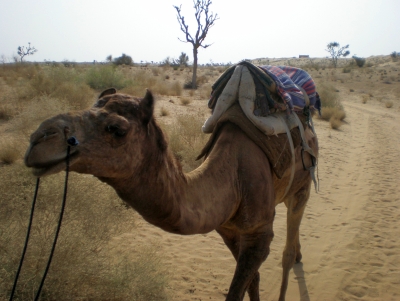
There are surely easier — and less smelly — ways to travel through Rajastan’s Thar Desert. But with a face like that, who could say “no” to a camel?
By Lucy Corne
As I bounced around in the camel cart trying to cling on to a bale of half-chewed hay, I was surprised to find myself thinking that I’d actually rather be riding one of these animals. Of course, being sandwiched between two camels, pondering which end emits a worse odor is not the most enviable position to be in, but I never thought I’d actually feel comfortable sitting atop a camel’s hump.
Quite a step for someone who, just 24 hours earlier, actually burst into involuntary tears at the mere thought of even touching a camel. It was a series of mistakes and coincidences that had led us to Bikaner, a relatively quiet corner of India’s much-visited Rajasthan province. Unable to secure tickets to the prettier, more popular city of Jodhpur, we opted instead for an overnight train to Bikaner, an untidy town in the northern reaches of India’s Thar Desert. With plans to stay a night and then head north to the Himalayas, we asked a rickshaw driver to take us to the closest cheap hotel. Our lack of Hindi and clear status as backpackers led him to presume that we were here for an overnight camel trek — seemingly the only reason people detour to Bikaner — and drove us away from downtown to Vijay’s Guesthouse, home of the infamous “Camel Man.”
Having seen numerous camels pulling carts through Bikaner’s center, I had warmed to them a little, thanks to their seemingly docile nature. And once I realized that they weren’t vicious beasts, I didn’t have to look at too many of Vijay’s stunning photos to convince myself that a night in the desert would be a pleasing respite from the hectic pace of India, even if it did mean riding a camel. So the following morning we arose early and jumped on a truck headed for the starting point of the trek, a ramshackle village clinging to the edge of the desert. It was then that I began to regret my impulsive decision.
I’ve always been afraid of animals. Well, four-legged, furry animals to be precise. Put me in a room with a snake, a tarantula or a whole swarm of bugs and I’m perfectly happy, but ask me to touch or much worse ride anything with four legs and fur and I become a gibbering wreck. Which is exactly what happened when I caught my first glimpse of Boss, the adolescent camel that would be my steed for the next 24 hours.
But the initial panic that saw me bawling as Boss wobbled and swayed to get to his feet soon wore off. Suddenly I realized that not only had my pounding heartbeat slowed to a normal pace and my hands ceased to shake, but I was actually smiling. Traveling in India is many things: vibrant and lively, hectic and fascinating; but it can also be noisily frustrating. So exploring a traffic-free desert on camelback provided a much needed breather from the traffic-clogged, pedestrian-filled, sidewalk-less streets of the average Indian city. As we left the city, an undeniable calm settled in as the sound of camels passing wind replaced the annoyance of perpetually honking rickshaws, and the sight of hard-haggling traders gave way to a glimpse of resilient blackbuck or nilgai, a sturdy antelope often sighted in these parts.
By the time we reached Himdasa — our mid-morning oasis tea stop — a bizarre realization dawned: I was actually enjoying myself. Panic had been replaced by serenity and perhaps a little pride at facing one of my fears head on. So when Boss knelt down to allow me to climb off his back I felt none of the fear that I had an hour earlier. Until, that is, I set foot on the ground and he instantly ran away, much to the chagrin of Mander, the teenage handler whose home we were visiting in this mud-brick village. While Mander chased Boss, his younger brother led us into the simple courtyard of their home for a cup of the milky, insanely sweet tea that we had come to tolerate if not enjoy while exploring the subcontinent.
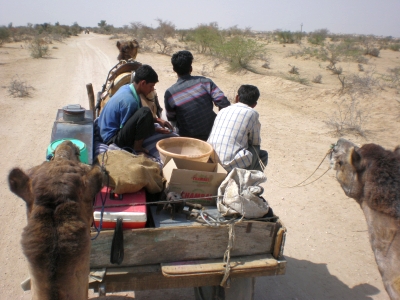 I was feeling refreshed and thoroughly confident when I went to remount Boss, who was safely tethered to a tree having been chased down by an angry Mander. None of the nerves that had plagued me in the morning were present as I attempted to climb aboard, but they all came flooding back when my wayward camel took to his feet before I could even get my first foot in the stirrup, much less sit down. I had no idea I could move so quickly and was surprised to find myself 10 yards from the animal, on the other side of Himdasa’s dusty square. My second attempt was a far less confident one, but at least Boss waited until I was settled in the heavily padded saddle before he stood and continued along the route.
I was feeling refreshed and thoroughly confident when I went to remount Boss, who was safely tethered to a tree having been chased down by an angry Mander. None of the nerves that had plagued me in the morning were present as I attempted to climb aboard, but they all came flooding back when my wayward camel took to his feet before I could even get my first foot in the stirrup, much less sit down. I had no idea I could move so quickly and was surprised to find myself 10 yards from the animal, on the other side of Himdasa’s dusty square. My second attempt was a far less confident one, but at least Boss waited until I was settled in the heavily padded saddle before he stood and continued along the route.
The rest of the afternoon passed without incident, though not without enjoyment. The near silence of the desert was disturbed only by the belching, farting and defecating of our steeds, none of which detracted from the surprisingly soothing experience of bouncing along on a hump. Before lunch I even managed to work up enough poise to let go with one hand in order to get a few snaps of the occasional antelope in the distance.
Eating in India is always a highlight, but the impromptu feast that our lead guide Kamer rustled up in the middle of the desert was unforgettable. Together with a nearly cold post-lunch beer in the shade of a Khejri tree, and it was utter bliss. Only one thing could have improved this situation and it was then that Kamer came over and informed us that we would now nap for an hour or two until the sun lowered. Perfection accomplished.
Following the finest siesta I’ve ever enjoyed, we were ready to jump back onto the camels as they obediently followed the cart carrying our guides and other essentials. The sun was starting to set as we reached our camp and we were thrilled to find a well-stocked shed filled with little extras to make our night in the desert even more comfortable than we’d hoped. I felt more like a wealthy safari-goer than a backpacker as we dined at a table complete with tablecloth and placemats, savoring the enchanting silence as we tucked into another hearty meal of dhal and rice. After a much-appreciated beer and a short and slightly awkward “cultural performance” (theater is always a little uncomfortable when there are more spectators than participants and you’re not sure what the ticket fee should be), we retired early to gaze at the stars and snuggle on to the six-inch thick mattresses in our solitary tent.
It would have been a perfect night. The temperature was ideal and there were no partying neighbors or infuriating mosquitoes to deal with. If only the howling dog that appeared from nowhere hadn’t kept us awake all night we would have arisen refreshed and enthusiastic. Instead we awoke grumpy and hating anything with four legs, so when offered the choice to ride back or jump aboard the camel cart we opted for the latter, assured by Kamer that most travelers choose the comfier option on the return leg. Of course, comfort is somewhat subjective, and I soon decided that being jolted around on a pile of blankets atop a camel’s hump would have been more relaxing than sitting on a bag that contained the animal’s breakfast, with the camel in question following close behind looking for his morning snack. Upon returning I was somewhat proud to find that given the chance to change my mind, I would have ridden the camel back in a flash.

The post Hump Day: My Camel Trek In India appeared first on The Expeditioner Travel Site.
]]>The post Top 8 Ways To See Cape Town Through A Different Lens appeared first on The Expeditioner Travel Site.
]]>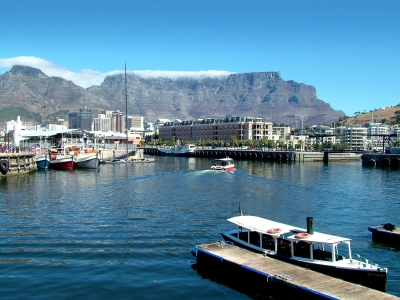
If you’re looking for a way to get away from the madding crowds in Cape Town, try these 8 alternative ways to see the city through a different lens.
By Lucy Corne
Cape Town is one of those places that everyone should visit in their lifetime. It has everything: natural beauty, a vibrant cocktail of cultures, belt-expanding food and wonderfully welcoming people. Many attractions have reputations that precede them — I’d heard of the Cape of Good Hope and Robben Island before I had any idea what or where they were — but what if you want to step off the beaten track? The main attractions are undeniably outstanding, but when the swarms of tourists get too much, you might want to seek out a quieter way to enjoy the “Mother City.” Here are eight alternatives to the tour bus favorites.
1) Follow the crowds: Take the cable car up Table Mountain
An original take: Hike to the top of Lion’s Head
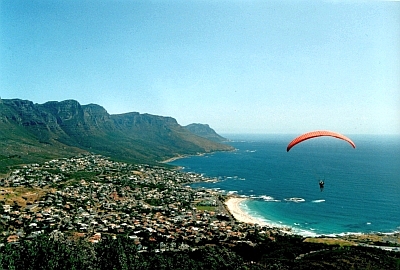 Table Mountain tops most people’s list of things to do in Cape Town, but there are more options than just jumping on the revolving cableway to reach the mountain’s flat top. You could join the energetic travelers who hike to the 1,086-meter summit or, for a less congested hike, opt to scale nearby Lion’s Head. It’s a challenging hike that takes in narrow paths, steep drops and occasionally has you grasping on to chains to haul yourself up the rocks. Still it’s all worth it for the stunning views — in my opinion far superior to the vistas from the top of Table Mountain. Of course, since Lion’s Head is just a couple of kilometers away from the mountain, the panoramas are similar: ocean views and the city laid out beneath you. But seen from Lion’s Head you get an added bonus, Table Mountain is part of the view as well. If clambering to the top is not thrilling enough for you, book a paragliding tour and take the more adventurous route back to sea level.
Table Mountain tops most people’s list of things to do in Cape Town, but there are more options than just jumping on the revolving cableway to reach the mountain’s flat top. You could join the energetic travelers who hike to the 1,086-meter summit or, for a less congested hike, opt to scale nearby Lion’s Head. It’s a challenging hike that takes in narrow paths, steep drops and occasionally has you grasping on to chains to haul yourself up the rocks. Still it’s all worth it for the stunning views — in my opinion far superior to the vistas from the top of Table Mountain. Of course, since Lion’s Head is just a couple of kilometers away from the mountain, the panoramas are similar: ocean views and the city laid out beneath you. But seen from Lion’s Head you get an added bonus, Table Mountain is part of the view as well. If clambering to the top is not thrilling enough for you, book a paragliding tour and take the more adventurous route back to sea level.
2) Follow the crowds: Sip wine in picture-perfect Constantia
An original take: Down beer at the SAB Brewery in Newlands
South Africa is often associated with wine, but you don’t have to spend long in the country to realize that you’re in a nation of beer lovers. The Ohlsson’s Brewery in Newlands might lack the aesthetic value of the Constantia winelands just south of the city, but the informative tour through a fully functioning brewery makes up for the lack of prettiness. And of course, once the hour-long tour ends, the fun really begins as you’re left in the on-site pub to taste SAB’s many different brews.
3) Follow the crowds: Paddle with penguins in Simon’s Town
An original take: Take a boat to see seals near Fish Hoek
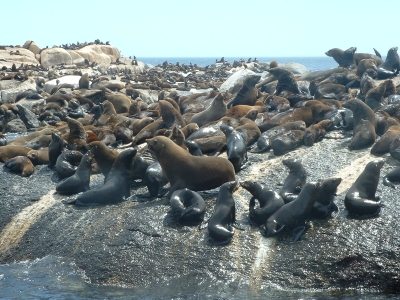 There aren’t many places where you can paddle in a boat amongst penguins, and I wouldn’t for a second suggest that you miss out on Boulder’s Beach and its colony of African Penguins, but there are other notable wildlife encounters around Cape Town. Jump on one of the regular boats from Fish Hoek’s harbor and visit the small colony of Cape Fur Seals lounging on an island a couple of bays away. Be prepared for the overwhelming stench; they might look cute, but they smell like rotting fish. The choppy boats also take in a shipwreck before heading back to Fish Hoek’s stunning beach. Those who don’t mind venturing a little further should head to the real Seal Island in False Bay. There are hundreds of seals here and the waters are a favorite lunch stop for Great White Sharks.
There aren’t many places where you can paddle in a boat amongst penguins, and I wouldn’t for a second suggest that you miss out on Boulder’s Beach and its colony of African Penguins, but there are other notable wildlife encounters around Cape Town. Jump on one of the regular boats from Fish Hoek’s harbor and visit the small colony of Cape Fur Seals lounging on an island a couple of bays away. Be prepared for the overwhelming stench; they might look cute, but they smell like rotting fish. The choppy boats also take in a shipwreck before heading back to Fish Hoek’s stunning beach. Those who don’t mind venturing a little further should head to the real Seal Island in False Bay. There are hundreds of seals here and the waters are a favorite lunch stop for Great White Sharks.
4) Follow the crowds: Follow the Long Walk to Freedom on Robben Island
An original take: Follow in the footsteps of the San at !Khwa ttu
Okay, in truth there really is no substitute for the moving trip to Robben Island, home to the prison that held Nelson Mandela for 18 of his 27 years of incarceration. But once you’ve taken the choppy ferry over to the former prison and leper colony you might like to consider stepping a little further back in time to explore !Khwa ttu, a cultural center dedicated to the San, South Africa’s earliest dwellers. San descendants offer an insight into this forgotten culture and a quick lesson in their bizarre-sounding but delightful “clicking” language. The center is 70 kilometers north of Cape Town, near Yzerfontein.
5) Follow the crowds: Enjoy a relaxing picnic at the Kirstenbosch Botanical Gardens
An original take: Work for your lunch with a hike through the Kogelberg Nature Reserve
With its manicured lawns and dramatic mountain backdrop, Kirstenbosch is certainly beautiful and a great place to stroll, but if your trip to Cape Town is brief why not opt for a more challenging outdoor experience? The craggy mountain scenery is echoed at Kogelberg, but visitor numbers are limited, meaning you get a quieter, less polished encounter. The rugged terrain makes for wonderful hikes where you might spot small antelope, baboons, eagles and the locally famous herd of horses descended from those abandoned here after the Anglo-Boer War.
6) Follow the crowds: Chain stores and lunch at the V&A Waterfront
An original take: Haggling and lunch on Long Street
The Waterfront is one of Cape Town’s favorite attractions and its pedestrian-friendly complex of shops, cafes, bars and restaurants is definitely worth a visit. But prices here can be steep, and while undoubtedly pretty, the Waterfront lacks character. For a more vibrant buying and dining experience, head to Long Street, the heart and soul of central Cape Town. Shop for quirky souvenirs in the African Bead Store, lunch on local dishes or gourmet sandwiches in the hip cafes and end with a haggle in the Pan-African Market or Greenmarket Square — great places to pick up six-feet tall giraffes, township art crafted from trash and scary but perfectly-carved masks.
7) Follow the crowds: Have an emotional encounter at the District Six Museum
An original take: Have an emotional encounter at Lwandle’s Migrant Labour Museum
Visiting the District Six Museum is an utterly moving experience. It recounts one of the most hated policies of the apartheid regime: the forced removal of families from their homes across the country as regions were designated “white only.” The museum is excellent and never fails to have you reaching for your hankie, but sometimes the endless stream of tour groups can detract from the poignancy of the exhibits. If you have a rental car and feel like supporting a project in need, head east of the city to Lwandle, a township near Somerset West. After visiting the deserted but excellently laid-out museum, staff will take you on a walking tour to visit the former hostels — depressing boarding houses built for migrant workers who were forced to leave their families behind as they searched for work in the cities.
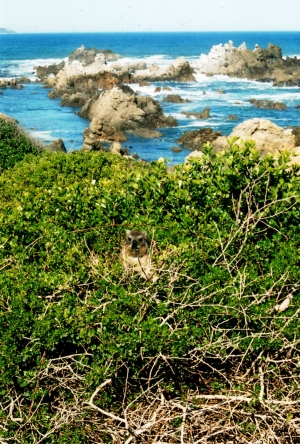 8) Follow the crowds: Get snap-happy at the Cape of Good Hope and Cape Point
8) Follow the crowds: Get snap-happy at the Cape of Good Hope and Cape Point
An original take: Head to the real “end of the world” at Cape Agulhas
It’s a common misconception: Crowds of tourists descend daily on the Cape of Good Hope, intent on visiting the southernmost tip of Africa and snapping a few shots of the Atlantic and Indian Oceans meeting offshore. Sadly, neither of these things is possible here. Stunning views are a given, as are hordes of tourists and a few rogue baboons stealing people’s picnics, but the real “end of the world” is actually 200 kilometers east of Cape Town. Cape Agulhas can’t compete with Cape Point’s dramatic scenery, but it certainly holds the trump card in tranquility. There’s not a lot here other than a very photogenic lighthouse, a shipwreck and a far less-photographed sign than the one found at the Cape of Good Hope, but if you’re the kind of traveler who likes superlatives, silence or photos of significant signs, then it’s definitely worth the trek.

The post Top 8 Ways To See Cape Town Through A Different Lens appeared first on The Expeditioner Travel Site.
]]>